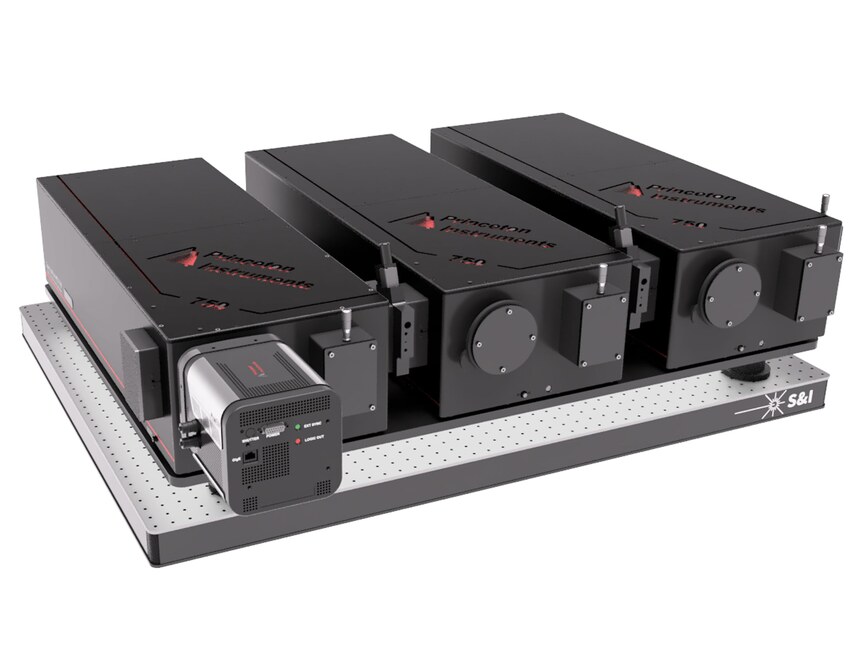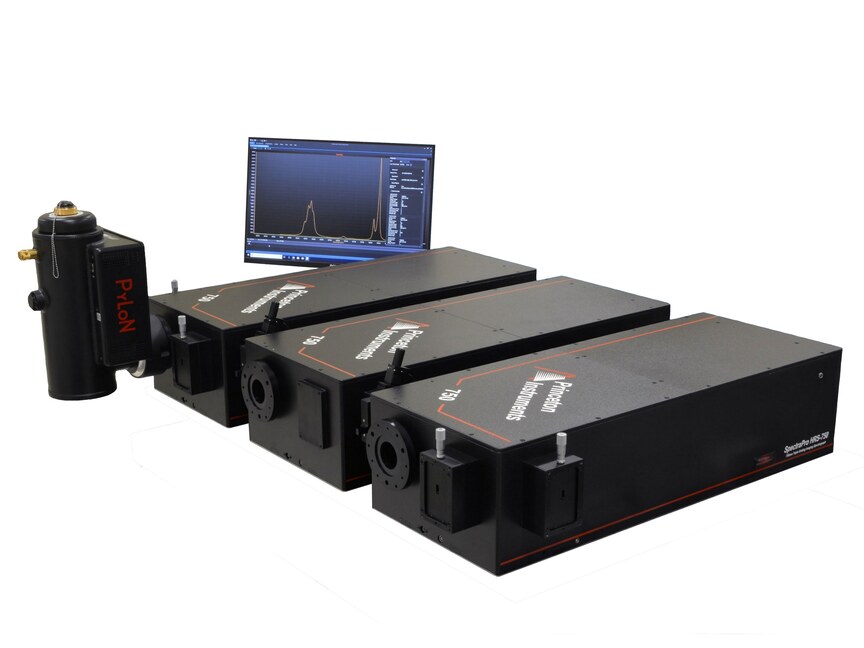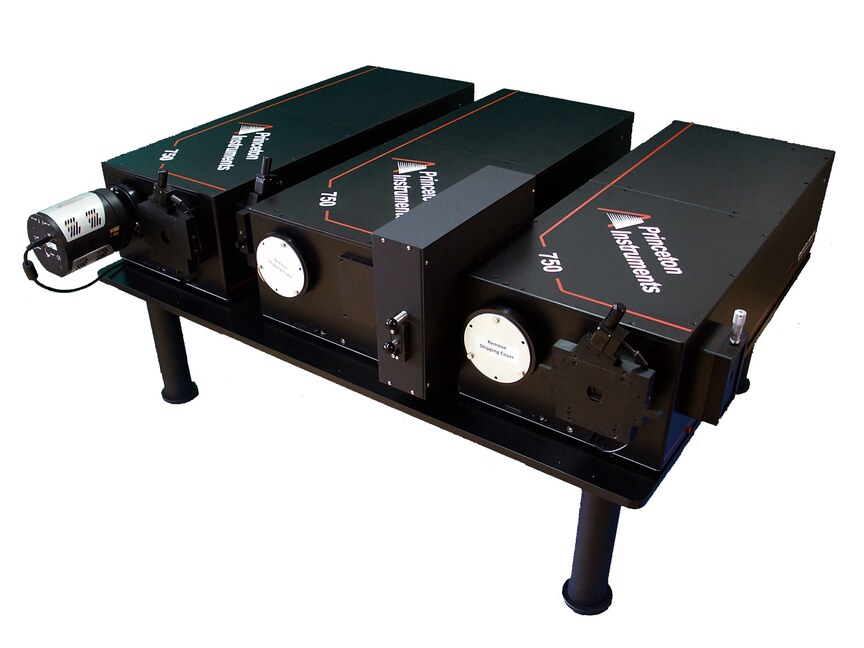TriVista Basic
The TriVista Triple-Monochromator-System is a ultra-high-end spectroscopic measurement system
It is the entrance into the triple-based Raman and photoluminescence spectroscopy.
It combines the highest-possible resolution bandpass capability of a DuoVista, with the unmatched spectral resolution, throughput and imaging capabilities of S&I's MonoVista systems.
All TriVista systems are based on the successful Princeton Instruments SpectraPro HRS imaging monochromator series.
While the TriVista is best suited for customers with previous knowledge in the field of spectroscopy, due to it providing a wide array of free degree usage, our VistaControl Software and various options for extensive motorization of the entire equipment (TriVista CRS³) can help to significantly flatten the learning curve and make it almost as easy to handle as one of our MonoVista systems is.
TriVista Systems are best suited for ultra-high-end applications providing the best solution for
- The necessity of ultra-high resolution in additive dispersion providing an unbeatable spectral resolution (i.e. FWHM < 0.002 nm / 0.08 cm-1 at 633 nm on a TR777)
- Lowest frequency measurements down to ≤ 5 cm-1 in subtractive mode (≤ 1.5 cm-1 for single-point detectors)
- Variable excitation-wavelengths experiments supported to observe the dependence of Raman spectra with respect to the excitation-wavelength
S&I can provide and propose multiple different tuneable lasers, to unlock the TriVistas full potential - Maximum flexibility and optional enhancements, like a huge selection of different types of microscopes, lasers and accessories for various applications
please also see our TriVista CRS³ and Custom microscopes
The standard (Basic) TriVista consists of a base plate, for a sturdy and movement-free connection between the three stages and is available in three different sizes:
TR333i – double stage 300 mm Czerny-Turner monochromator bandpass and 300 mm Czerny-Turner monochromator imaging stage
TR335i – double stage 300 mm Czerny-Turner monochromator bandpass and 500 mm Czerny-Turner monochromator imaging stage
TR555i – double stage 500 mm Czerny-Turner monochromator bandpass and 500 mm Czerny-Turner monochromator imaging stage
TR557i – double stage 500 mm Czerny-Turner monochromator bandpass and 750 mm Czerny-Turner monochromator imaging stage
TR777i – double stage 750 mm Czerny-Turner monochromator bandpass and 750 mm Czerny-Turner monochromator imaging stage
Features
Additive-Mode

In additive dispersion-mode each stage of the spectrometer-system disperses the spectrum of the incoming light. So, each stage adds an additional dispersion. The first monochromator stage disperses the spectral radiation into separate wavelength components, allowing a specific spectral window to enter the next stage. The same way as the second stage, the third stage adds a third dispersion to the spectrum which is finally coupled to a detector in the last stage with even a lower level of stray light.
The possible resolution is as high as for a single spectrometer with a focal length which is equal to the sum of the focal length of the 3 stages.
Subtractive-Mode

In subtractive mode, the first and the second stages of spectrometer work as a tunable bandpass filter to allow only the desired portion of spectrum to pass through and reducing stray light levels.
A polychromatic light enters the first stage through the entrance slit and is dispersed by the first grating. The intermediate Slit acts as a bandpass filter passing only the light between wavelengths λ1 and λ2. The grating in the second Stage recombines all the dispersed light and focuses it into the entrance slit of the third stage, producing again a polychromatic light limited to the spectral range between wavelengths λ1 and λ2.
- Deep UV to IR wavelength range
- High spectral resolution, i.e. FWHM < 0.002 nm / 0.08 cm–1 at 633 nm (TR777i in additive mode)
- Low frequency Raman measurements down to 5 cm-1 or less, depending on sample
(≤ 1.5 cm-1 for single-point detectors) - Operable for unlimited amount of laser wavelength in the range from DUV to NIR
- Useful for tunable laser-excitation
- Easy automated switching via VistaControl Software between “Additive” and “Subtractive” dispersion-mode
Please note:
TR333i and TR335i can only be set up in either subtractive or additive mode
Only TR555i, TR557i and TR777i support subtractive and additive modes on one system - Simultanious Stokes / Anti-Stokes Measurements
- Easy switch between Triple- and Single-Stage Operations (with optional Bypass-enhancement)
Components
Spectograph
- Additive and Subtractive Dispersion
- Image corrected optics provide superior imaging quality for multi-track applications
- Multiple entrance and exit ports
- Interchangeable Grating Turrets with 3 gratings per turret per stage
(up to 27 gratings on 9 turrets possible) - Choice of more than 100 gratings available for the best spectral range, throughput and dispersion
- Motorized entrance and exit slits with 10 µm to 3 mm width
- Motorized intermediate slits with 10 µm to 12 mm width
- Bypass to switch the entrance beam between first, second and third stage
- Stokes / Anti-Stokes Accessory
- Optional Silver-, Gold- or MgF2-coated mirrors
- Stepping motor scanning system with microprocessor control provides superior precision and repeatability of wavelength positioning
- Optional internal shutter for experiments requiring background removal or signal attenuation
Multiple configurations
A variety of configuration enables a wide field of applications. Up to four input ports and four output ports provide a wide range of different system setups.
The additive or subtractive arrangement of the double monochromator stage can be selected by software. Switching between additive and subtractive mode is done inside the first two Stages without any need of an additional optic.
So the Double Monochromator Stage can be used together with the last stage as a Triple system for Raman Spectroscopy.
Setup for Micro and Macro Raman Spectroscopy in Triple additive and subtractive Mode

It can also be used as an excitation stage for Fluorescence and Photoluminescence and the emission can be detected by the last stage of the system.
Setup for Photoluminescence & Fluorescence

Setup to run three experiments simultaneously

Also, a bypass system is available to switch the entrance beam between the entrance slit of the first and third stage of the TriVista.
Accessories
- Optic sets for automated polarization measurements (UV to IR)
- Optic sets for Line-Focus measurements
- Macro-Raman Chamber and Macro-Raman Accessory for microscopes
- Motorized XYZ-stages with stepsize < 50 nm
- Piezo XYZ-stages with stepsize < 10 nm
- Heating/Cooling stages
- Heating stage, temperature limit at 1500 °C
- Combined Heating/Cooling stages, working range: -196°C - 600°C
- Helium cryostats (with and without cryogen) with temperature limit at a few Kelvin
- AFM from A.P.E. Instruments for TERS and AFM-Raman mapping
- Coupling to beam-lines possible via free-beam or fiber-coupling
Macro Raman Chamber
- Useful for solids, liquids and gases
- f/2 entrance optics
- Laser focussing lens
- Holder for Interference filter (without filters)
- Variable Incidence for Solids
- Horizontal beam for Liquids and Gases
- 180° Illumination
- Multipass mirrors
- Retro collecting mirror
- X-Y-Z sample movement (optionally motorized)



